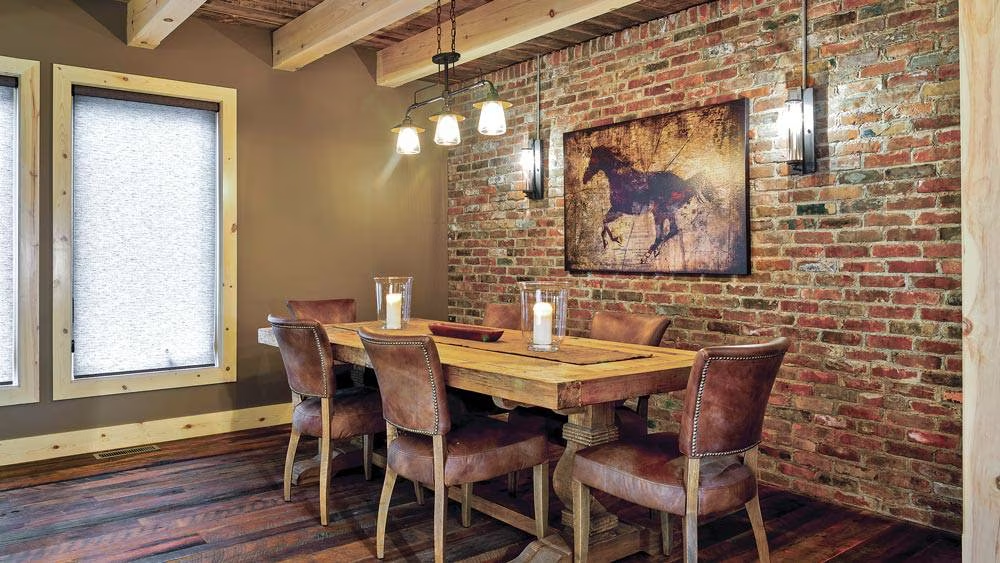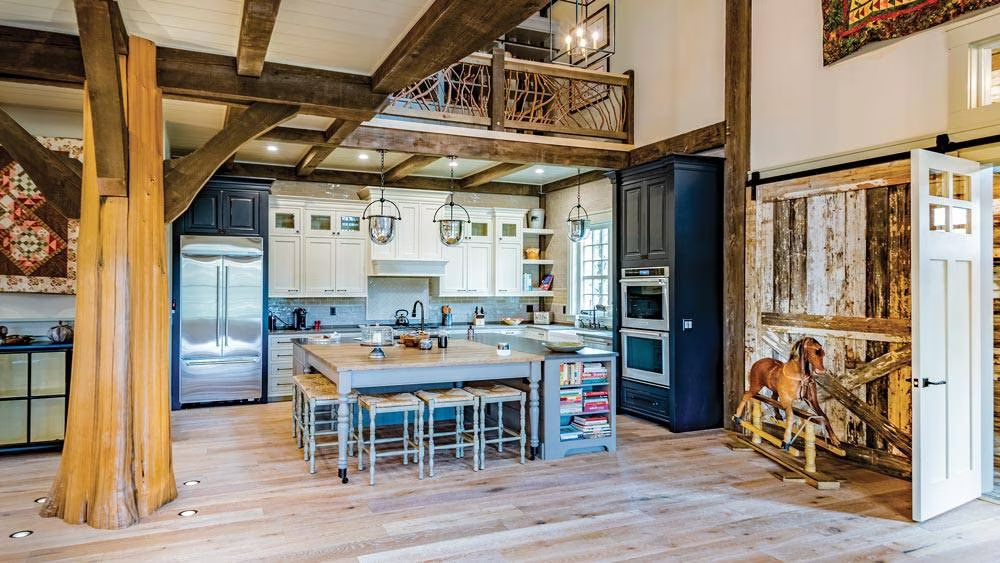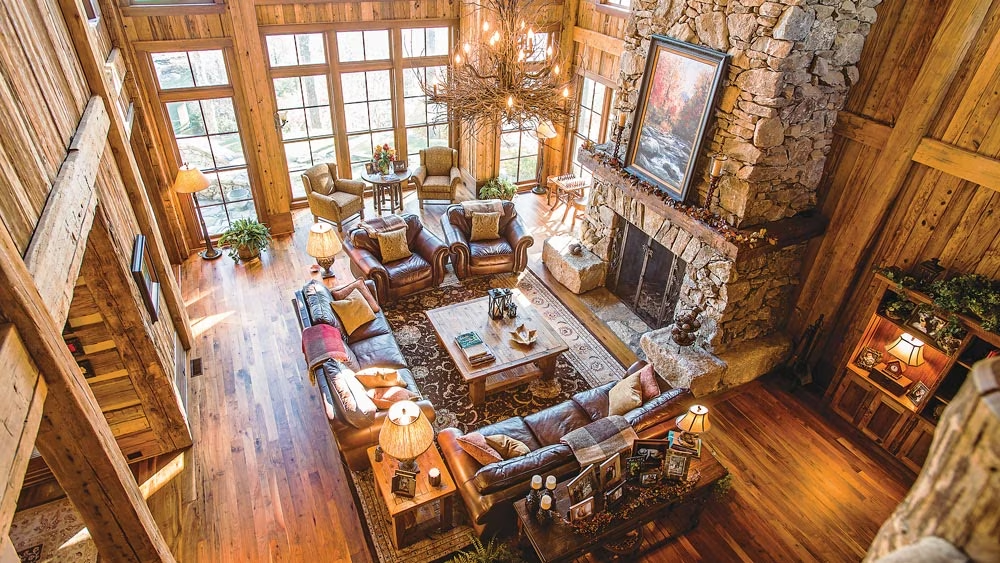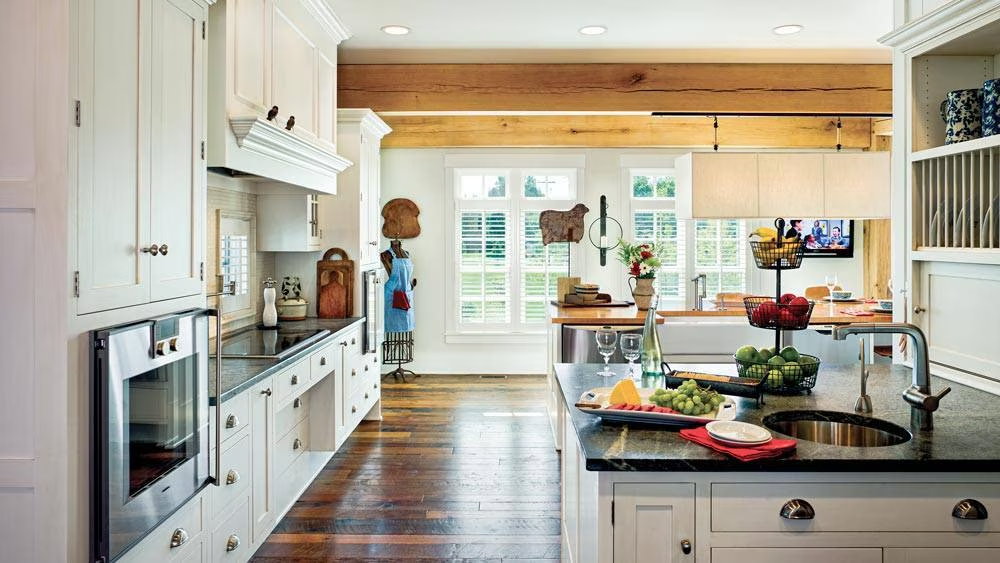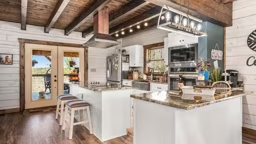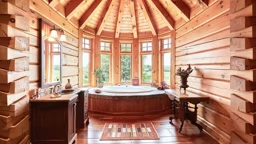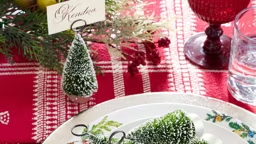Some design and decor trends come and go in a flash. Others linger a little longer. And then there are those motifs that seem to be repeated again and again, year after year. The latter go beyond “trend” and become part of the language of log and timber home design.
Do you keep seeing a log or timber frame home theme that you love, but you are not sure what it’s called? For clarity, we turned to two seasoned interior designers to define the most popular features their clients request the most while building their own log and timber frame homes.
1. Rustic Farmhouse
“Rustic farmhouse and barn style have gained a lot of ground in the past 10 years, thanks to DIY channels and certain popular home-makeover shows,” says Molly Cooper, lead interior design coordinator at Cooper & Co. in Moss, Tennessee. “Adding in massive wooden timbers and logs will not only add to the farmhouse look but elevate it into something spectacular. A true ‘old timey’ farmhouse was built of timbers and logs milled from the properties they were built on, so to incorporate them into modern design only seems natural.”
Common rustic farmhouse elements include:
-
Exposed ceiling beams
-
Reclaimed wood accents
-
Exposed stone or brick walls (both interior and exterior)
-
Hand-scraped hardwood flooring
-
Distressed and handcrafted items
-
A large hearth in the great room, either gas or wood-burning
-
Prominent staircases, often built with half-logs and twigs
-
Darker stains instead of paint
2. Modern Farmhouse
The modern farmhouse style continues to be highly sought after, according to Cassandra Christianson, Allied ASID interior designer and project coordinator at Wisconsin Log Homes, Inc., and WLH Custom Homes, LLC, in Green Bay, Wisconsin.
There are subtle differences between a modern farmhouse and its rustic cousin. The modern variety tends to be a little brighter, softer and more polished.
“Lighter wood floors are very popular with white walls, painted shiplap, stained ceiling beams and black accents, keeping everything bright and crisp,” Cassandra says. “There are also a lot of vintage design styles coming back, with deep blues, greens and burgundy colors used in rugs and throws. Antique-gold lighting and plumbing fixtures are used to create that vintage style as well.”
Molly says home buyers seek sleek, modern takes on the farmhouse approach with an attention to detail. “Folks still gravitate toward the style, but they seem to want less of the shabby-chic side of it,” Molly explains. “You now see cleaner lines, and instead of going all-white, buyers are adding in pops of color like blues, grays and greens,” she says, echoing Cassandra’s sentiments.
And while the look is still quintessential modern farmhouse, there have been a few recent shifts in this motif. “While painted white cabinets have been so popular over the past 10 years, the trend has turned, and a new bleached-out, raw-wood look for cabinetry has prevailed,” Molly says. “Wide-plank floors may never go out again, but the dark, rich colors seem to have taken a downturn, with light and airy tones topping the must-have charts.”
“Timber and log homes are still utilizing distressed floors and reclaimed beams, Cassandra adds. “We’re also seeing stone that has over-grouted joints for a more ‘Old-World’ feel.”
Common modern farmhouse elements include:
-
Custom backsplashes, especially painted cement tile
-
Steel or brushed aluminum custom appliances
-
Wide and random-width-plank wood flooring in shades of blond and gray instead of brown
-
Over-grouted stone joints
-
Reclaimed beams
-
Bleached raw wood for cabinetry
-
Sliding barn doors
3. Full-on Rustic
When it comes to log and timber homes, this is one design motif that will never go out of style. You may have to give it a few minor updates from time to time, but the backbone of the design will remain steadfast.
“Rustic design is still a strong contender in what folks are looking for. They want to take a break from the cities and get back to nature, and what better way to do that than with a log or timber home?” Molly states.
“One of the most popular tourist towns here in Tennessee is Gatlinburg with a National Park right out the back door to thousands of log vacation homes, so many folks want to make one their everyday home,” she continues. “Buyers see the rustic-designed home as an environment where they are safe and comfortable, and all the wood elements provide the feeling that the outdoors are also indoors.”
Common full-on rustic elements include:
-
Milled or handcrafted log walls
-
Timber frame trusses over the public areas of the home, often with a hand-hewn (rough) finish.
-
Wide-plank wood floors in dark stain shades
-
Reclaimed wood, often with traces of the bark, nail holes or notches from their previous use intact
-
Countertops with chiseled or “live” edges
-
Knotty-wood cabinets left natural or painted rich shades
-
Wrap-around porches
-
Centrally positioned gas or wood-burning fireplaces
4. Future-Proof Design
Though not exactly a design motif in the decorative sense of the word, incorporating aging-in-place is a genuine concern — and one that does affect the look, feel and flow of a home.
“If you are set on building a home with multiple floors, especially if the lot you are building on requires it, add in an elevator or at least a predetermined area for one to be added at a later date,” Molly says. “Be sure your designer stacks nice-sized closets right on top of each other from the top floor down to the bottom to serve as the shaft. Keeping a ‘future’ elevator in mind as you design won’t end up being a hassle or a huge expense when the time comes to install it.
“A new trend that has evolved the past few years is a ‘wet area/tub-shower combo,’” Molly continues. “So, the shower is lipless and roll-in ready and the tub is all within the wet area and the drain is in the middle of the space for easy water drainage.”
Future-proof (aka universal design) elements include:
-
First-floor master suites (in a multi-level plan)
-
Curbless (no lip) showers and flush door sills
-
Residential elevators (or deliberate shafts for future lifts)
-
Wider doors and hallways to accommodate wheelchairs (36 to 42 inches wide)
-
Lever-style door handles and rocker light switches
-
Casement windows (crank operated) over the single- or double-hung variety
-
Wider garages




